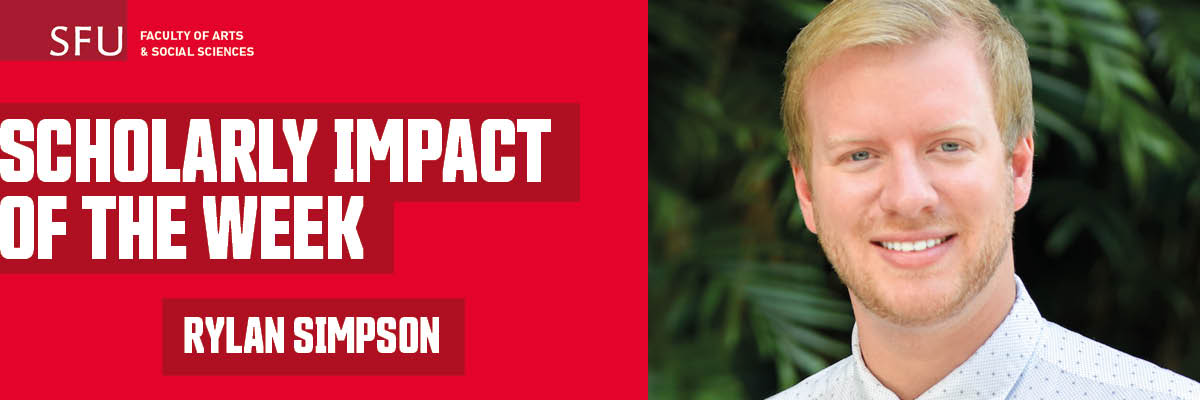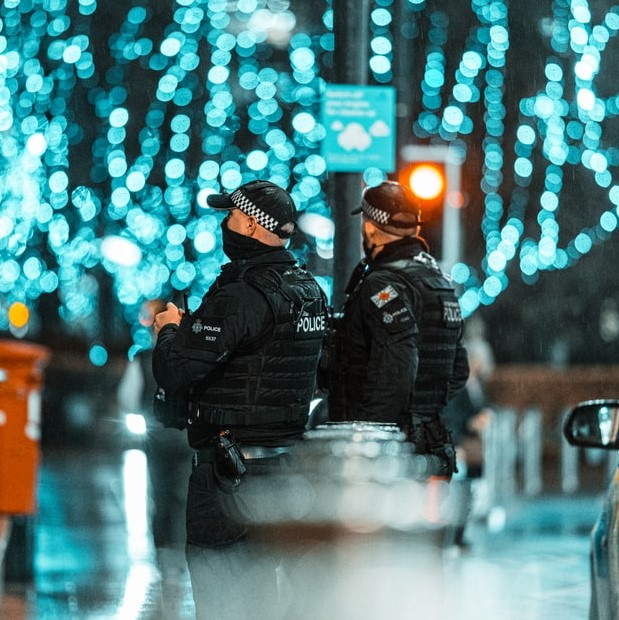
SFU Criminology professor Rylan Simpson understands the value of first impressions. He has participated in over 1000 hours of police ride-alongs with dozens of police organizations in several countries, and observed many types of policing in action.
Simpson’s research involves various areas of policing such as perceptions of police, social psychology, and police-public relations. He created The Police Officer Perception Project (POPP) which used an experimental methodology to gauge the public’s impressions of police in various attire and patrol situations. The project was some of the first work of its kind to study in-depth the first impressions of officers based on appearance, before any formal interaction. His most recent study, The use of personal protective equipment (PPE) by police during a public health crisis: An experimental test of public perception asks whether police are perceived favourably when using PPE.
The PPE paradox
As essential frontline workers and first responders during the pandemic, police are inevitably put in situations that increase their risk of exposure to COVID-19. Many have adopted the use of personal protective equipment (PPE), including gloves, face masks, face shields and eye protection, to keep themselves and the public safe.
And there lies the paradox. The role of police requires direct engagement with the public who depend on their services, but the use of PPE has not been widespread until the pandemic. Theoretically, PPE use should be perceived as positive: mask wearing, for example, is considered pro-social behaviour. However, not everyone believes in the severity of the virus, which suggests that the police’s use of PPE could be perceived as negative. In addition, masks and eye protection such as sunglasses can hinder communication. Simpson further hypothesized that specific types of masks, such as the full-face respirator mask, may be associated with police tactical or riot gear and elicit negative associations.
“The very items of PPE that police are using because of the pandemic are the same items that have historically been found to induce negative perceptions of police,” notes Simpson. “The goal of the study was to test this ‘PPE paradox.’ Do these items still produce negative perceptual effects, even when they are now necessary to protect the officers and those they come in contact with?” Aided by Master’s student Ryan Sandrin, Simpson designed and executed a study to test this hypothesis.
‘Unmasking’ PPE awareness
The first step was to assess the effects of public awareness about the benefits or lack thereof of PPE. Next, was to test public perceptions of the different types of PPE used by police.
Simpson and Sandrin sampled 117 participants from a variety of backgrounds and demographics. The groups were randomly divided and asked to read one of three different fictional news articles about either the health benefits of PPE or the lack of health benefits of PPE. The third article was neutral and did not mention PPE. “What we wanted to do was assess whether telling people that PPE was beneficial or not would have an impact on how they perceived the officers using PPE,” explains Simpson.
The study participants then rated 12 different images of a uniformed White male officer using different items of PPE. In the first six images, the officer wore one of the following: a surgical mask, an N95 mask, a full-face respirator mask, goggles, a clear face shield, or single-use light blue medical gloves.
In the subsequent five images, the officer used a combination of items including: medical gloves and a surgical mask; medical gloves and an N95 mask; medical gloves and a full-face respirator mask; medical gloves, an N95 mask, and goggles; or medical gloves, an N95 mask, goggles, and a clear face shield. In the twelfth and control image, the officer did not use any PPE.
These images were selected to not only isolate individual items of PPE, but also to examine the perceptual effects of popular combinations of PPE used by officers. All images of the officer were taken in a public environment with members of the public present but not focal. All 12 images featured the same officer, an actual police officer from a local police department. The images were rated across eight different dimensions: accountability, aggression, approachability, competency, friendliness, intimidation, professionalism, and respectfulness.
PPE appreciation – with some exceptions
Overall, the findings showed that most types of PPE did impact public perception favourably. 80% of study participants (regardless of condition) agreed or strongly agreed that police should use PPE whenever possible during the COVID-19 pandemic.
Regardless of which fictional news article the participant read, the use of the surgical mask or the N95 mask enhanced perceptions of accountability, professionalism, and respectfulness. Blue medical gloves also enhanced perceptions of accountability, competency, professionalism, and respectfulness. As well, using medical gloves and any form of mask generally enhanced perceptions of accountability, competency, professionalism, and respectfulness.

However, participants in both PPE conditions perceived the officer using a full-face respirator mask as more intimidating. The combination of medical gloves and a full-face respirator mask also amplified perceptions of aggression and intimidation for participants in both PPE conditions, and reduced perceptions of friendliness for participants in the anti-PPE condition. The full-face respirator mask thereby emerged as potentially problematic in the context of public perception.
Fewer negative effects were observed for the face shield, and any perceptual effects that were observed were positive. Finally, the results revealed that the effects of PPE are not completely additive: once salient items of PPE are already visible on the officer, the presence of additional items exhibits a negligible impact on overall perceptions of that officer.
“This study, along with my previous research, again illustrates that officer appearance matters” says Simpson. “And, with regards to pandemic protection, wearing items of PPE also matters. Most items exhibit a positive effect on perception, although some items can exhibit more mixed effects.”
The next step is the completion of a follow-up study, coming soon. And Rylan Simpson is continuing with this line of research working with officers in Canada and in Australia. He is grateful for the collaboration and assistance from the various police departments who have supported his work, and helped offer important insights into a key piece of pandemic policing.
SFU's Scholarly Impact of the Week series does not reflect the opinions or viewpoints of the university, but those of the scholars. The timing of articles in the series is chosen weeks or months in advance, based on a published set of criteria. Any correspondence with university or world events at the time of publication is purely coincidental.
For more information, please see SFU's Code of Faculty Ethics and Responsibilities and the statement on academic freedom.